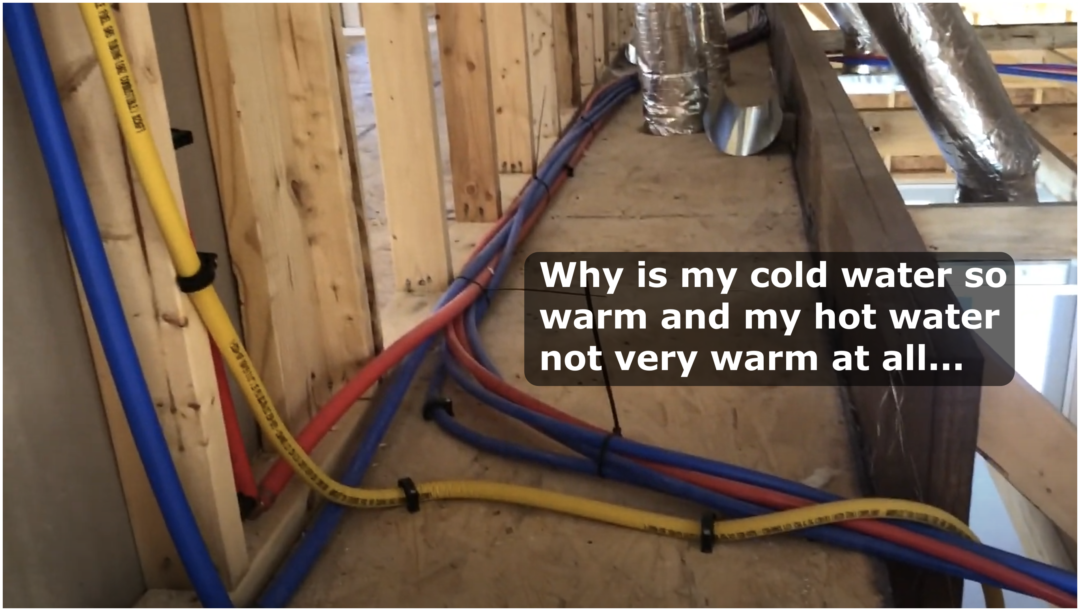When PEX (cross-linked polyethylene) pipes for hot and cold water are bundled together and touched, heat can transfer from the hot water pipes to the cold water pipes and vice versa.

This thermal transfer can affect the temperature of the cold water delivery, particularly if the hot and cold pipes are in close contact over long distances or if the ambient conditions favor such heat exchange, for example, if installed in an attic space in a hot climate zone like the deep south.
Some manufacturers (Uponor AquaPEX) allow bundling, but hot and cold bundles should be separated if uninsulated. (see page 23)
- Support the entire bundle at the required O.C. distances.
- Use cable ties to maintain a tight bundle of Uponor AquaPEX.
- Do not use cable ties as the sole means of supporting the bundle.
- Do not use wire ties, metal strapping, or duct tape for bundling.
- Keep hot and cold bundles 6″ apart if uninsulated.
- There is no restriction on the number of lines bundled.
The Zurn and pipe application guide states (page 15) that Zurn PEX’s heat transfer rate is “not a problem” and to check the requirements of the local code. Legend pipe refers to the Plastic Pipe and Fittings Association installation guide: Hot and cold lines may be bundled, but some jurisdictions do not permit this practice. Be sure to check with the local authority.
The Mississippi Building Code Council adopted the 2018 edition of the IPC in December 2019. Specific rule changes in the IPC 308.9 Parallel water distribution systems state: Piping bundles for manifold systems shall be supported in accordance with Table 308.5. Support for changes in direction shall be in accordance with the manufacturer’s instructions. Where hot water piping is bundled with cold water piping, each pipe shall be insulated per Section 607.5. (PDF)
Factors Affecting Thermal Transfer in PEX Pipes:
- Pipe Insulation: PEX pipes have some natural insulation properties, but these are insufficient to prevent heat transfer if the pipes are touching. Proper insulation is crucial, especially for hot water lines. The insulation will help prevent heat transfer to adjoining pipes and prevent the pipe from freezing in the winter.
- Distance and Exposure Time: The length of the run where the hot and cold pipes are in contact will affect the degree of heat transfer. Longer contact results in more opportunity for the cold water to warm up.
- Water Usage Patterns: Frequent use of hot water can lead to the hot pipes consistently being at a higher temperature, thereby increasing the likelihood of warming the cold water in adjacent pipes.
- Ambient Temperature: The environmental temperature around the pipes also plays a role. In warmer climates, like the ones we experience here in Mississippi, the ambient temperature can further exacerbate the warming of cold water lines.
Simple Mitigation Strategies:
- Physical Separation: Separate the hot and cold water lines to prevent direct contact. Even small gaps can significantly reduce heat transfer.
- Insulation: Properly insulate hot water pipes to reduce heat loss and prevent heat from radiating to nearby cold water pipes. An effective solution is to use foam pipe insulation sleeves that fit snugly around the PEX tubing.
- Piping Layout: Consider the piping layout and installation practices. Strategic routing and placement of hot and cold lines can help minimize crossover heat transfer. Designing the plumbing layout to avoid long parallel runs where hot and cold pipes are in contact is advisable.
- Use of Reflective Barriers: In some cases, especially in hot climates or unconditioned spaces, adding reflective barriers between hot and cold pipes may help reflect heat away from the cold pipes.
- Regular Maintenance: Check and maintain insulation regularly, especially in critical areas where pipes are close together. Over time, insulation can degrade or be displaced. Separating pipes provides clearer access for maintenance, repairs, and inspections, allowing each line to be more easily identified and serviced without interference from other lines.
Addressing these factors can help ensure that the cold water delivery remains within the desired temperature range, enhancing the plumbing system’s overall efficiency and comfort. Contact your local AHJ—Authority Having Jurisdiction for best practices in your area.

- - - - - - - - - - - - - - - - - - - - -